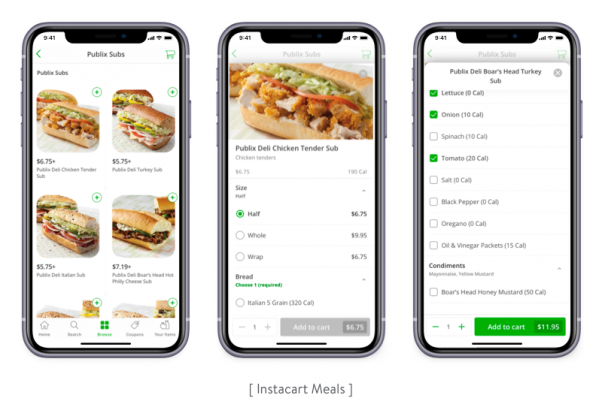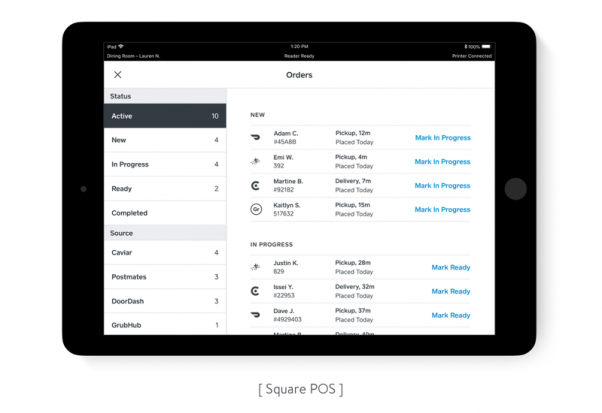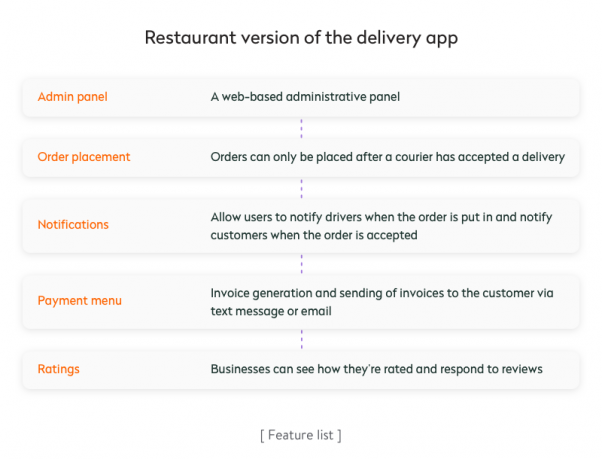Table of Contents
Food delivery is on the rise. In March 2020, 60 percent of adults in the UK aged 18 to 34 had already increased their delivery frequency and 26 percent were planning to do so according to Statista. The current situation is keeping people from going to public places and hence encouraging them to use takeaway or delivery options.
Under these circumstances, creating an on-demand delivery app or partnering with delivery service is the best chance for restaurants to stay afloat. It’s also a good time for companies to start a food delivery business.
When creating a food delivery application, companies often face a lot of challenges: how to find couriers, how to partner with restaurants, and so on. In this article, we provide a step-by-step guide on solving top challenges when starting a food delivery service.
Main challenges of building and promoting food delivery apps
Food delivery businesses face four major challenges:
1. Researching the target market
First and foremost, you should research your target market and decide on what type of delivery services you want to provide.
There are two main business models for online food delivery platform: restaurant-to-consumer and platform-to-consumer. Restaurant-to-consumer services deliver food from a specific chain of restaurants. Delivery apps from Domino’s Pizza, Pizza Hut, and KFC fall under this category.

Platform-to-consumer services focus on delivering food and products from different restaurants, cafes, bakeries, or grocery stores. This category is represented by apps like Postmates, UberEats, Deliveroo, and Grubhub.
To date, platform-to-consumer companies represent a significant part of the food delivery market, while restaurant-to-consumer deliveries are typically represented by major restaurant chains.
Next, it’s time to decide on your target audience. Within the food delivery industry, there are many types of services you can offer: you can deliver groceries, deliver curated menus that fit a diet along with the necessary ingredients (everything you need for Pad Thai, including the recipe), or deliver prepared foods (Caesar salad, burgers, and fries). Each of these options meets the needs of a separate target audience.
Who do the most successful food delivery apps target?
Apps like Statista target busy professionals who want healthier options from upscale grocery stores like Trader Joe’s. Instacart doesn’t deliver cooked foods, but recently it launched Instacart Meals, a new section that allows users to easily cook meals from a restaurant. With Instacart Meals, a user can choose any dish they want and the app will automatically find ingredients for it.

Uber Eats, Uber for delivery, is all about making tech-savvy millennials happy. Operating all over the world, Uber Eats delivers a wide selection of foods from different restaurants and cafes.
Postmates is similar to Uber Eats and shares the same target audience. But Postmates has widened their reach by offering to deliver anything, not just food right to the doorstep. In fact, some orders through Postmates are really small: maybe you forgot dishwasher liquid or a bar of soap when you went to the store. But these small orders are what keeps Postmates running, as they guarantee a constant supply of orders for their couriers.
2. Partnering with restaurants and grocery stores
Any new delivery service has to make sure they’re noticed, which means they need to reach out to as many restaurants as they can. A wide network of partner restaurants gives a new app enough of a push to get traction and win over a share of the market. How is this normally done?
Companies that focus on grocery deliveries source their ingredients directly from local farms. Farmdrop is an example of a grocery delivery app that solves the problem of sourcing high-quality organic ingredients by partnering with farmers in the London and New York areas. By partnering directly with farmers, Farmdrop doesn’t have to worry about being overstocked with a certain type of produce. This business model appeals to environmentally conscious users who want to support local organic farming.
Companies such as Zomato and Grubhub build partnerships with local food establishments, drive their partners’ delivery costs down, and then take a commission for sales. To establish a long-lasting partnership with restaurant business owners, you should offer valuable benefits.
How delivery companies attract partners
DoorDash, Grubhub, and Postmates have all resorted in the past to a risky strategy for gathering a customer base — one which has attracted a lot of criticism and negative reviews. These services were all found to have delivered from restaurants they hadn’t signed any agreements with. Not all restaurant owners are happy about their menus being published without their consent, so you should avoid this idea. Choose any of the following strategies to attract partners.
Food delivery service Zomato attracts restaurants by offering applications that streamline operations. Zomato Order is a mobile app for Android and iOS that allows restaurants to easily accept online orders, while Zomato Book offers advanced table reservations and staff management. You can also create an application for restaurant partners.
Grubhub has gone even further by introducing Ultimate technology — pioneering ecosystems consisting of hardware solutions connected to Grubhub’s web app and mobile app.
There are four elements of Ultimate technology: a lightweight point of sale (POS) system, a kitchen display system (KDS), heads-up customer displays, and an in-store self-ordering kiosk. All devices are integrated with the GrubHub mobile and web apps and are closely interconnected. The pilot version of this technology is being used in 100 locations in Chicago and New York. This solution may cost you a pretty penny, but there are other options available.
Foodpanda provides its partners with small POS terminals from Sunmi that allow them to easily change menus and availability as well as print receipts. The Foodpanda device is easy to set up and has all the needed automation systems already installed.
Famous point-of-sale provider Square has partnered with Postmates and DoorDash to ease order management. When a user makes an order in Postmates, it automatically appears in the restaurant’s POS system. Other delivery platforms work with Chowly, an order aggregator that partners with local delivery services and POS systems. You can also try to partner with a local POS provider or partner with companies like Chowly and Deliverect that connect restaurants’ POS systems and delivery platforms.

You can develop your own management system that will attract new partners. Provide restaurants with an easy-to-use iPad based POS system that allows for:
Creating rooms. Any restaurant management system needs to let you model and manage rooms. 9Cookies app, for example, helps to create miniature models of your restaurant rooms with all the furnishings – tables, room dividers, etc. Users can set up tables just by dragging and dropping them from the panel, can choose from a variety of floor surfaces that suit your restaurant, and can scale and move objects and delete them if necessary.
Accepting delivery orders. 9Cookies integrates tightly with Delivery Hero, so restaurant managers are instantly notified about new orders placed via the Delivery Hero platform. After you get a new delivery, you can either accept or reject it. Once you accept a new delivery request, you can view order details: items ordered, total due, customer name and address, and preferred payment method. You can then select an expected delivery time and assign this delivery to one of your drivers. Accepting orders from in-restaurant visitors should also be implemented.
Tracking delivery. Once a delivery is assigned to a driver, you can watch their movements live on your iPad, which is possible thanks to a GPS tracking feature. The app also allows you to settle payments with a driver either after each delivery or at the end of the day.
Reporting. Reporting functionality is a source of valuable insights for your restaurant business. For example, you can find out which dishes are selling best at what times and which dishes were sold most frequently. Using this information, not only will you be able to see how your business is doing, but you will also be able to design effective marketing strategies that can help you gain even more business.
More features might include self-service kiosks, staff management, ingredient inventory, CRM integration, and loyalty programs.
3. Deciding whether to have drivers on your payroll or contract with drivers the way Uber does
There are two primary ways delivery services find drivers:
The Uber-like method is much more common among food and grocery delivery services, particularly in the US, since almost anyone with a car who wants a part-time job is a potential worker.
Companies like Grubhub and Seamless that mostly operate in busy urban areas opt for working with freelancers. Depending on the size and location of the market, some companies choose to hire their own drivers. DoorDash, Grubhub, and Postmates allow anyone with a car or bicycle to become part of their on-demand courier fleets.
If you decide to work with freelancers, you should pay attention to some pitfalls of this option:
To eliminate cases of driver fraud, conduct background checks of drivers just like Amazon, Grubhub, and Postmates do. Instacart, Grubhub, and Postmates use the third-party service Checkr to run background checks.
Unfortunately, accidents are all too common among drivers. And your business may be liable for some or all of the damages. Having the appropriate insurance is a good first step to protect your drivers. But you should also look into training your drivers to be aware of the risks. Postmates provides insurance for their drivers as well as conducts training for couriers. When Postmates drivers are on the clock, they’re protected with Postmates insurance, which covers bodily injury and property damage to third parties. Having car insurance is mandatory for every courier who uses a car in their work with Grubhub and DoorDash.
Though classifying drivers as independent contractors may cut operational costs, it can result in significant liability risks. Recently, three plaintiffs from California, Illinois, and Massachusetts filed a worker misclassification lawsuit against DoorDash. They claim DoorDash illegally labeled them as independent contractors. To mitigate risks, it’s best to consult with a lawyer or insurance professional before hiring freelancers.
For recently launched food delivery services, having their own couriers often seems like too much expense and commitment, but it’s advisable to hire at least a certain number of full-time employees once your company reaches a stable level of orders.
No matter what option you choose, you should provide your delivery crew with a courier app that allows them to accept orders, view the locations of deliveries on the map, and create the best route from restaurant to a customer. This app should also have real-time tracking functionality.

4. Mobile app development: choosing the right scope of features
The majority of food delivery services have separate apps for drivers, restaurants, and customers, for both iPhones and Android devices.
Based on our experience in food delivery app development as well as analyzing market leaders and current industry trends, we’ve created three templates that include all the essential features you need in a customer app, restaurant app, and courier app.
First and foremost, build a convenient customer app.

The courier version of an app is simpler and only has a handful of the most important features:

The version for restaurants includes an admin panel and all necessary features for placing orders and managing notifications:

It will take time and effort, but choosing the right target audience, building strong partnerships with restaurants and drivers, and focusing on the most essential features in your app will certainly put your business ahead of your competitors.
How to cover all your business scenarios in one go?
As your business gets mature, there appear more needs and possible scenarios of its growth and development. You may be considering adding several monetization models, adjusting your marketing strategy or scaling the product to enter new markets. At this point, you may come across the following tasks to be solved:
Here most product owners start thinking of SaaS software development services that would combine solving major business tasks and allow them to manage all the operations, resources, and finances from a unified system. In the long run, such a holistic approach helps to optimize operating costs, avoid any delays in the workflow, minimize risks, and make the process of development predictable.
Tips on how to build a food delivery business the right way:



